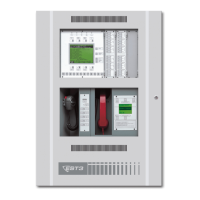Installation
EST3 Installation and Service Manual 5.31
rules disable accounts on the failed 3-MODCOM and enable
matching accounts on the backup 3-MODCOM.
When a 3-MODCOM acts as a backup it still provides line
supervision. Only the backup accounts are disabled. Further,
backup units should conduct their own dialer tests, using unique
accounts that identify the 3-MODCOM. Even when not in use, a
backup unit should generate a trouble event if it cannot contact
the assigned receiver.
Because of the way rules are processed, when the primary
3-MODCOM comes out of trouble, the accounts are
automatically switched back to their normal state. Messages
already queued for transmission in the backup unit will still be
sent, even after backup accounts are disabled. Only new
messages will be routed differently. This means that device
activation and restoral messages sent to the CMS will still be
properly paired.
Failover operation is created by specific configuration and
programming steps. These are outlined below.
Configuration requirements
• For each primary 3-MODCOM add (or select) a backup
3-MODCOM in the same panel or in a different panel
according to the scope of failover operation you need
• Configure the primary and backup 3-MODCOMs identically
except for their labels and the labels of the accounts
• Label the accounts so that it’s easy to recognize the
3-MODCOM in which they are used
• Make sure each 3-MODCOM uses a unique account for
dialer tests
Programming requirements
• Create message rules that send identical messages to both
accounts
• On system startup, disable the accounts on the backup
3-MODCOM
• On activation of a panel comm fault, line fault, or LRM
comm fault, disable the primary accounts and enable the
backup accounts
ACDB requirements
Additional steps are required when the project includes reporting
to a CMS that requires translation from a Cardholder ID to a
cardholder name. In this situation, the ACDB user must enter a
User ID (name) for both CMS Accounts (the primary and backup
accounts).

